| Introduction |
|
While we are busy with a range of studies assessing the impacts of N2Africa across the different countries, there are still many ongoing PhDs who are writing up their theses and publishing their work. ...
Photo: Focus group discussion in northern Ghana, June 2019. See article "Sharing project benefits" by Eva Thuijsman
|
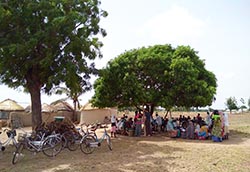 |
|
1 |
| Genetic diversity of indigenous rhizobia nodulating soyabean in grassland and cultivated fields of South Kivu, D.R.Congo |
We studied the genetic diversity of indigenous rhizobia nodulating soyabean in South Kivu province of D.R.Congo in order to compare the diversity in grassland and cultivated farms but also to identify indigenous rhizobia with potential of increasing soyabean’BNF and productivity. Soyabean (Glycine max) is an important crop worldwide and especially in Democratic Republic of the Congo, promoted since 1990 to deal with high malnutrition induced by political strife (Kismul et al., 2015). ...
|
2 |
| Symbiotic interaction between chickpea (Cicer arietinum L.) genotypes and Mesorhizobium Strains in Ethiopia |
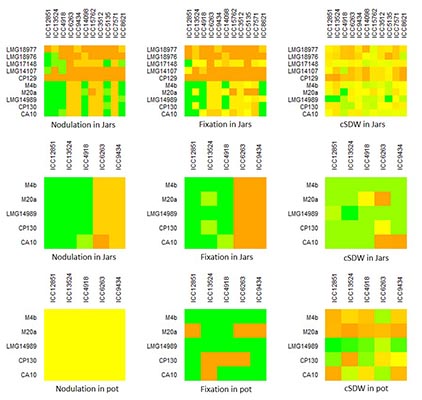 |
Chickpea (Cicer arietinum L.) is one of the grain legumes that symbiotically interact with Mesorhizobium strains and fix atmospheric N. The efficiency of the symbiotic N fixation partly depends on the host genotype (GL) and rhizobium strains (GR). Here, we studied GL x GR interaction between genetically determined Mesorhizobium strains and chickpea genotypes primarily in jars and subsequently in pots in Ethiopia. ...
Figure: Nodulation, fixation and shoot biomass patterns of GL x GR in chickpea. Where, cSDW is corrected shoot dry weight; Chickpea genotypes are indicated on the x-axis while strains are indicated on the y-axis.
|
|
3 |
| Influence of product bundling on farmers’ preferences to buy soyabean inputs: A conjoint study in Ethiopia |
|
In my previous year PhD update, I qualitatively explored and highlighted the influence of smallholder farmers’ perceptions of legume seeds, inoculant, fertilizer and improved practices on their adoption intentions. As farmers perceive high relative product advantage with the legume inputs, they also perceive low compatibility with prices and packaging of the inputs. ...
Picture: Farmers on soyabean input product preference rating task at Bako district.
|
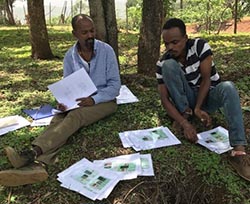 |
|
4 |
| Allocation of grain legume fodders in mixed crop-livestock systems of northern Ghana |
|
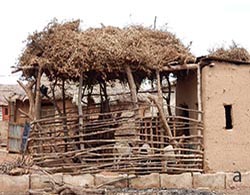
|
Crop residues are a major feed resource in smallholder mixed crop-livestock (MCL) systems in West Africa. The current decline in grazing land as a result of the ever-increasing population and associated increased demand for land for housing and crop production has further heightened the importance of crop residues as livestock feed. Grain legume residues, ...
Photo: Grain legume fodders stored for stall feeding
|
|
5 |
| Understanding smallholder farming systems in the Guinea savanna of Ghana for targeting grain legume intensification options |
|
In this update, I provide a highlight from my last chapter focussed on providing an improved understanding of smallholder farming systems in the Guinea savanna of northern Ghana for targeting of grain legume intensification options.
Figure: Food availability and food self-sufficiency of farm households in (a, c) Northern region (NR) and (b, d) Upper East region (UER) of Ghana.
|
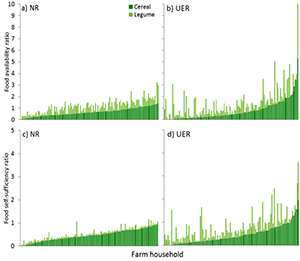 |
|
6 |
| My PhD results’ harvest! |
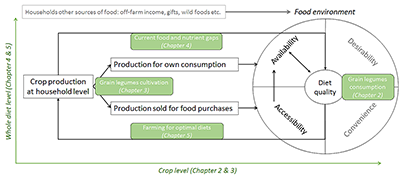 |
In June I successfully defended my thesis entitled ‘Harvesting nutrition. Grain legumes and nutritious diets in sub-Saharan Africa!’ What a special day!
The figure shows an overview of the studies we conducted within a framework based on the theoretical concepts of agriculture and nutrition pathways and the food environment.
|
|
7 |
| Sharing project benefits |
|
Last June, a small case study was done in northern Ghana to investigate how farmers perceived their interactions with N2Africa. Any agricultural development project – N2Africa included – can work with only a limited number of people.
Photo: Focus group discussion in northern Ghana, June 2019
|
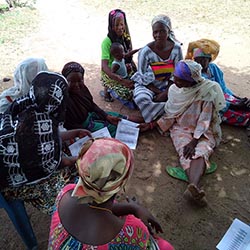 |
|
8 |
| Diverse Bradyrhizobia strains can nodulate cowpea in Nigerian soils |
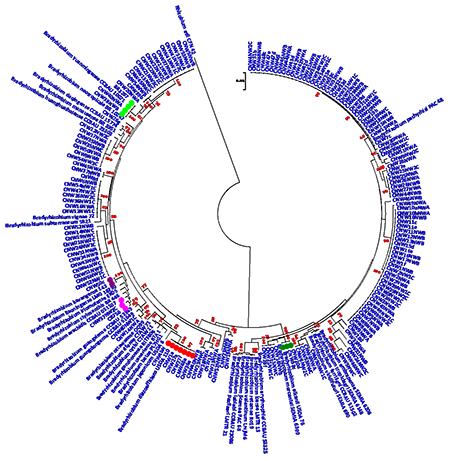 |
Cowpea is an important grain legume valued for its N2-fixing ability and nutritional attributes of its grain and leaves. The symbiotic relationship of cowpea with its microsymbiont rhizobia do account for 96% of its N requirement, can as well contribute to the N needs of subsequent cereal crops in Sub-Saharan Africa, ...
Figure: Maximum likelihood phylogeny of cowpea nodulating rhizobia from Nigeria based on concatenated sequences of 16SrRNA-glnII-gyrB-recA genes
|
|
9 |
| Responses of cowpea (Vigna unguiculata L. Walp) varieties to rhizobia inoculation, phosphorus application and sequential cropping system in Minna, Nigeria |
My study aimed to exploit rhizobia inoculation, phosphorus application, varietal differences and sequential cropping system to improve the productivity and profitability of cowpea per unit area in Minna, Nigeria. Glasshouse and field experiments were conducted between 2015 and 2017. ...
|
10 |
| Enhancing biological nitrogen fixation and yield of soyabean and common bean in smallholder farming systems of Rwanda |
|
Climbing bean is a very important crop in Rwanda especially in the highlands of the Northern Province. However, yields achieved by farmers in the area remain low. This is due to overexploitation of the tiny lands with little or no fertilizer use. ...
Figure: CND (a, c) and DRIS (b, d) nutrient index values for leaf tissue at Kinoni (a, b) and Muko (c, d) sites.
|
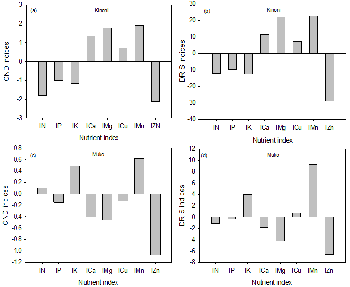 |
|
11 |
| The Role of the Integrated Maize-Soyabean-Chicken Value Chains in Sustaining Diverse Diets: the case of Southern Highlands of Tanzania |
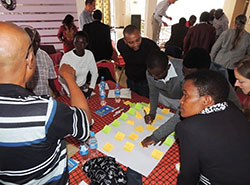 |
Six months after his MSc Animal Sciences, Wilson Charles returned to Wageningen University in April 2018 for a PhD program while registered at Plant Production Systems group. Primarily, he joined N2Africa and The Missing Middle project ...
Figure: A participatory workshop on value chain mapping and stakeholders analysis in Iringa region.
|
|
12 |
| Legume Technologies’ adoption among smallholders: Role of ICT market interventions and impact |
| African farmers are increasingly presented with innovative technologies to maximise their agricultural production potential and remain food secure. One of the innovations has been through the biological nitrogen fixation project N2Africa promoting proven legume technology packages (Improved seed varieties, phosphorus fertilisers, inoculants for improved productivity. ... |
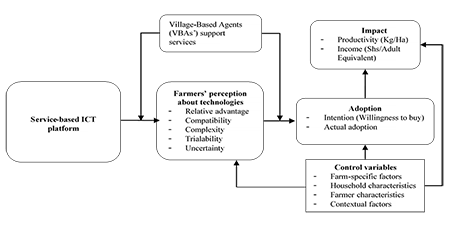 |
|
13 |
| Genetic diversity and symbiotic efficiency of indigenous and naturalised soyabean root nodule from Zimbabwe |
I carried out glasshouse and laboratory work at Murdoch University, with Zimbabwean isolates of soyabean root nodule bacteria that I collected from soils with a history of inoculation in Zimbabwe. I worked with a total of 137 soyabean root nodule bacteria isolates that were revealed by molecular methods to be drawn from the four species, Bradyrhizobium diazoefficiens, B. elkanii, B. japonicum and B. ottawaense. ...
|
14 |
| Overview of students that, to date, completed their PhD |
See which nine PhD graduated and find the link to their theses.
|
15 |
| N2Africa publications |
Nodulation, Nitrogen Fixation and Productivity of Cowpea (Vigna unguiculata) Varieties as Influenced by Rhizobial Inoculation and Phosphorus Application on Farmers’ Fields in Minna, Southern Guinea Savanna of Nigeria. 2018 by O.A. Adediran, A. O. Osunde, A. Bala, M. Dianda, H. Ibrahim, O. O. Olufajo and J. A. Oladiran.
|
16 |
| Reports and other output uploaded on the N2Africa website |
Responses to inoculation of Phaseolus beans on N2Africa trials in Ethiopia, Tanzania, Rwanda and Zimbabwe.
|
17 |
| Related newsletters |
SeedSystems blog: Institutionalizing Quality Declared Seed (QDS) Systems in Uganda;
Icrisat news: First ever high-yielding chickpea variety developed using marker-assisted backcrossing (MABC) released in Ethiopia;
Tropical Grasslands: Forages for the future newsletter 9.
|
18 |
| Announcements |
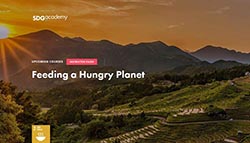 |
We are pleased to announce the re-launch of Feeding a Hungry Planet: Agriculture, Nutrition and Sustainability!
This new run of Feeding a Hungry Planet will launch on 9 September 2019 as a year-long self-paced course.
Learners can join at any time and access all the material at once, completing the course in its entirety or choosing the content that is most relevant to them. Enrollment is open now.
|
|
19 |













